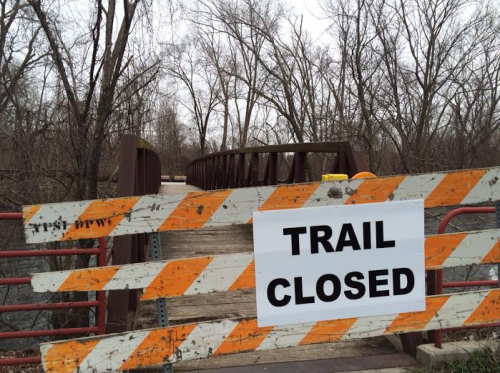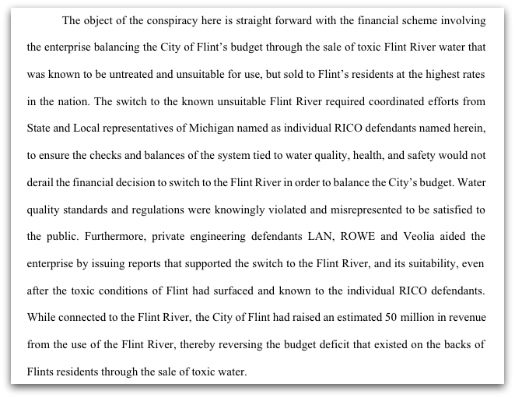
As we’ve all known for quite a while now, evidence that Flint’s children were being poisoned began to surface shortly after it was decided to begin sourcing municipal water from the Flint River in a move to further reduce costs associated with running the once prosperous city, which had been taken over by a governor appointed emergency manager in 2011. This, as we also now know, likely wouldn’t have been an issue if the powers-that-be had followed the EPA regulation known as the Lead and Copper Rule (LCR), which demands “public water systems serving more than 50,000 people… survey their own corrosion control systems and replace their pipelines with state-approved corrosion control.” But, for whatever reason, someone chose not to do that in Flint – not to add the $100 worth of chemicals each day that would have stopped the lead pipes from corroding, sending increasingly toxic water into people’s homes. And that’s something that a lot of us have puzzled over since this story first broke. “Why,” we ask ourselves, “would anyone break the law and endanger the inhabitants of an entire city, just to save $100 a day?” Well, according to the Detroit Free Press, we may now know the answer… The following clip comes from the Detroit Free Press:
…Up to this point, it’s been hard to understand why the state didn’t require Flint to use corrosion control, chemicals that stop lead from leaching into the city’s water supply. And the state’s rationale, that it misunderstood federal guidelines, has mystified water treatment experts interviewed by the Free Press. It also drew scorn from the Flint Water Advisory Task Force, appointed by Gov. Rick Snyder himself to investigate the crisis — the task force called MDEQ’s interpretation of the rule “egregious” and “lax,” saying it bypassed important and obvious questions about water safety.
But testimony at a legislative hearing this week from the city’s utilities chief may help explain why: When Flint began to pump drinking water from the Flint River, the city’s water treatment plant wasn’t capable of adding corrosion control treatment, not without equipment upgrades the broke city couldn’t afford.
In fact, Flint didn’t start to install the required equipment until November 2015, when MDEQ signed off on a October permit application for a temporary phosphate feed system while a permanent feed was under construction, according to state records.
That’s the same month Snyder finally acknowledged that there was a problem in Flint, that the abundant evidence amassed by independent researchers was accurate, and that the city’s drinking water was not safe.
It’s critical context for understanding the state’s disastrous decision-making in Flint.
Michael Glasgow, then a lab supervisor and now the city’s utilities administrator, testified Tuesday at a legislative hearing about the Flint water crisis.
The state has said, for months, that MDEQ misinterpreted the federal Lead and Copper Rule, a guideline for treating water to prevent the kind of public health crisis that happened in Flint — because water pumped from the Flint River hadn’t been dosed with corrosion control chemicals, the city’s residents were exposed to lead-contaminated water, for almost two years, including nearly 9,000 children younger than 6.
And even after the U.S. Environmental Protection Agency told the state last spring that Flint must begin corrosion control immediately, the state didn’t act — in official emails, claiming it was appropriate to continue monitoring the city’s water before changing its treatment, even as two rounds of state testing showed lead levels in the city’s drinking water climbing.
The decision to skip corrosion control certainly didn’t save money. Corrosion-control chemicals, which keep lead contained by coating the inside of plumbing pipes, are cheap; some reports estimate the cost of treating Flint River water at less than $150 a day.
Plant upgrades, however, are expensive. A 2014 engineering report, performed in conjunction with a bond offering for a new regional water authority the state OK’d Flint to join in 2013, said the local treatment plant would require $8 million in upgrades to process the Lake Huron water the new system would pump…
So the decision not to treat the water from the Flint River, it would seem, at east in the opinion of the Free Press, was made primarily because the city’s emergency manager didn’t want to spend the money necessary for the the “6,000-gallon bulk storage tank, a transfer pump and a 120-gallon day tank and chemical metering pumps,” that were identified as being necessary in order to comply with EPA corrosion control regulations. So it’s not that people didn’t understand the EPA’s Lead and Copper Rule. They did. There were both 2009 and 2014 reports that spelled out exactly which plant upgrades would be necessary before transitioning to Flint River water. Somewhere along the line, though, it was clearly decided that the price tag of $8 million was too high for a city in bankruptcy.
It’s also worth noting, I think, that, when it first came to light that no corrosion control had been used in Flint, leadership at the Michigan Department of Environmental Quality (MDEQ) denied it.
When asked about corrosion control this past October 2nd, MDEQ Director Dan Wyant told the people of Flint the following. “Know that when the city switched from Detroit sewer and water, that the city utilized corrosion controls,” he said.
This, of course, was not true.
Wyant admitted as much on December 16, when al Jazeera correspondent Lori Jane Gliha asked him, “When you said corrosion control was in place in Flint, was that true?” To his credit, he responded truthfully. “No,” he said.
Wyant, of course, would eventually lose his job at the MDEQ, as would MDEQ spokesperson Brad Wurfel, who, like Wyant, had told the people of Flint not to worry about the water that they were drinking. It was Wurfel, as you might recall, who announced this past July, “Anyone who is concerned about lead in the drinking water in Flint can relax.” Wurfel, it’s worth noting, made this claim a full year after the people of Flint first started coming forward, saying that the water was making them ill.
While it’s still unclear when the administration knew definitively that the people of Flint were being poisoned by their drinking water, we know for certain that, when Wurfel told the people of Flint to “relax,” he had already seen the leaked EPA report showing extremely high lead levels in the water. So, when Wurfel told the people of Flint to go ahead and keep drinking the water in July, and when Snyder this past December said that it was “premature to come to conclusions” on the safety of Flint’s drinking water, as “a lot of lead issues can happen because of lead-based paint in someone’s home,” we can say with some degree of certainty that they were lying. They knew that lead was in the water, and they knew that it was the water, and not lead paint, that was cause of lead poisoning in Flint’s children. In spite of this, though, they continued to tell people that the water was safe, and that the cases of lead poisoning could be the result of other factors.
To make matters worse, it also appears that reports may have been falsified in order to keep the federal government from taking action. Here, with more on that, is a clip from CNN.
Michigan officials may have altered sample data to lower the city of Flint’s water lead-level reports, according to official documents and a researcher who conducted extensive tests there over the last six months.
Documents and emails show discrepancies between two reports detailing the toxicity of lead samples collected by the Michigan Department of Environmental Quality and the city of Flint between January and June 2015, Professor Marc Edwards from Virginia Tech University said.
Edwards is the lead researcher for the Flint Water Study, a research group that has conducted numerous tests on Flint’s system and was the first to publicly identify high levels of lead in the water.
The documents and emails were released by researchers from Virginia Polytechnic Institute and State University through a Freedom of Information Act request and viewed by CNN.
According to Edwards, the Michigan Department of Environmental Quality and the city of Flint collected 71 lead level samples from homes when they were required to collect 100. The final report from the Department of Environmental Quality however, only accounted for 69 of those 71 samples.
Edwards said those two discarded samples were “high-lead” and would have lifted the “action level” above 15 parts per billion. The public must be alerted and additional action must be taken if lead concentrations exceed an “action level” of 15 parts per billion in drinking water, according to the Environmental Protection Agency’s website…
Apparently, behind the scenes, there was a battle taking place between the Snyder administration and the EPA, which had become aware of how serious the issue in Flint was this past April. According to a report in the Detroit News, the EPA was pushing for the Snyder administration to put corrosion control in place, and the Snyder administration was pushing back.
…The U.S. Environmental Protection Agency’s top Midwest official said her department knew as early as April about the lack of corrosion controls in Flint’s water supply — a situation that likely put residents at risk for lead contamination — but said her hands were tied in bringing the information to the public.
Starting with inquiries made in February, the federal agency battled Michigan’s Department of Environmental Quality behind the scenes for at least six months over whether Flint needed to use chemical treatments to keep lead lines and plumbing connections from leaching into drinking water. The EPA did not publicize its concern that Flint residents’ health was jeopardized by the state’s insistence that such controls were not required by law.
Instead of moving quickly to verify the concerns or take preventative measures, federal officials opted to prod the DEQ to act, EPA Region 5 Administrator Susan Hedman told The Detroit News this week. Hedman said she sought a legal opinion on whether the EPA could force action, but it wasn’t completed until November.
The state didn’t agree to apply corrosion controls until late July and didn’t publicly concede until October that it erroneously applied the federal Lead and Copper Rule overseeing water quality.
An EPA water expert, Miguel Del Toral, identified potential problems with Flint’s drinking water in February, confirmed the suspicions in April and summarized the looming problem in a June internal memo. The state decided in October to change Flint’s drinking water source from the corrosive Flint River back to the Detroit water system…
Not only did the MDEQ continue to fight against the implementation, but Brad Wurfel came out publicly in September dismissing Del Toral as a “rogue employee” who shouldn’t be listened to.
When you look at the totality of the evidence, I don’t know how you can come to any other conclusion than this happened to the people of Flint because a decision was made by the Snyder-appointed emergency manager to cut spending at all costs, with no thought as to the health or wellbeing of the people. They knew the law, and they knew the costs of implementing corrosion control, but yet they chose to roll the dice, hoping that they’d make the switch to the KWA pipeline before people started to show signs of having been poisoned. This, as others have said, should be considered a criminal case.
 In an interview I did with John Doe of the band X a year or so back, he mentioned that he was writing a book of his own to set the record straight with regard to the history of the LA punk scene. [As you might recall, he wasn’t too happy with the job former LA club owner Brendan Mullen had done with We Got the Neutron Bomb: The Untold Story of L.A. Punk.] Well, I guess it’s now done. I just got word this morning that Doe’s Under the Big Black Sun: A Personal History of L.A. Punk is now rolling out to bookstores.
In an interview I did with John Doe of the band X a year or so back, he mentioned that he was writing a book of his own to set the record straight with regard to the history of the LA punk scene. [As you might recall, he wasn’t too happy with the job former LA club owner Brendan Mullen had done with We Got the Neutron Bomb: The Untold Story of L.A. Punk.] Well, I guess it’s now done. I just got word this morning that Doe’s Under the Big Black Sun: A Personal History of L.A. Punk is now rolling out to bookstores. 














